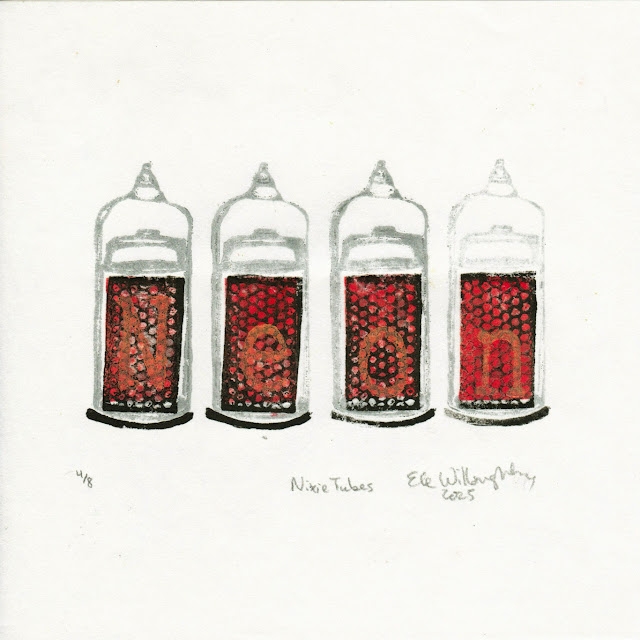 |
| Nixie Tubes, 8" x 8" linocut by Ele Willoughby, 2025 |
I wasn't sure what to make for the #PrinterSolstice2425 prompts neon because it's a famously un-reactive noble gas. It does play a role in stellar nucleosynthesis, but that was the subject of my last print. Copper on the other hand has such a long history and huge role in art and science that I didn't know where to begin. I opted for Nixie tubes and horseshoe crabs.
Nixie tubes, also known as or cold cathode display, are electronic devices used for displaying letters or numerals or other information using glow discharge. Introduced in 1955, they are prized today for their vintage aesthetics. Inside a glass tube, there's a wire-mesh honeycomb-shaped anode, and if you look carefully you can make out the multiple cathodes shaped like alphanumeric characters (here printed in silver). When a cathode is powered it becomes surrounded with an orange glow discharge. The tube is filled with a gas at low pressure, usually neon with a small amount of argon.
 |
| Horshoe crab, 8" x 8" linocut by Ele Willoughby, 2025 |
My hand-printed horseshoe crab (Tachypeus gigas) is hand-printed in grey, blue-bronze and dark brown on 8" x 8" cream-coloured Japanese paper with bark inclusions. They get their name from their horseshoe like shape but they are not crabs; they are chelicerates, more closely related to arachnids and they are "living fossils" which have changed very little since they first appeared in the Triassic. The textured sandy paper is meant to look like sand on a beach. They actually swim with their underside up, but prefer to stay on the sea bottom.
There are four species of horseshoe crab which are still living. T. gigas is a species from the Indo-Pacific. The blood of horseshoe crabs (like most mollusks) contains the copper-containing protein hemocyanin rather than hemoglobin (the iron-containing protein), which is the basis of oxygen transport in vertebrates. Colourless when deoxygenated hemocyanin turns dark blue when oxygenated. In circulation, the horseshoe crab's blue is grey-white to pale yellow, but if exposed to air when they bleed, it turns dark blue. Hemocyanin carries oxygen in extracellular fluid, unlike the oxygen transport in vertebrates by hemoglobin in red blood cells.
Tachypleus gigas inhabits seagrass meadows, sandy and muddy shores at depths to 40 m (130 ft) and is the only horseshoe crab to have been observed swimming at the surface of the ocean. It lives in both marine and brackish waters in tropical South and Southeast Asia.









No comments:
Post a Comment